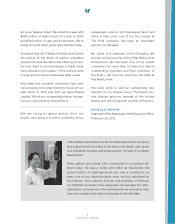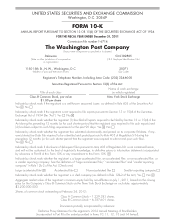Washington Post 2011 Annual Report Download - page 19
Download and view the complete annual report
Please find page 19 of the 2011 Washington Post annual report below. You can navigate through the pages in the report by either clicking on the pages listed below, or by using the keyword search tool below to find specific information within the annual report.KHE Campuses OPEID units, representing approximately 11% of KHE’s 2011 revenues, could have a 90/10 ratio over
90%. As noted above, Kaplan is taking steps to address compliance with the 90/10 rule; however, there can be no
guarantee that these measures will be adequate to prevent the 90/10 rule calculations from exceeding 90% in the future.
Given that schools do not control, and generally may not limit, student lending, one of the more effective methods of
reducing the 90/10 rule percentage is to increase tuition prices above the applicable maximums for Title IV student loans
and grants, requiring other sources of funding to cover the remaining tuition balance, in order to reduce the percentage of
revenue from Title IV sources. Although modification of the 90/10 rule could limit this potential undesirable impact on
tuition, there is no indication that the U.S. Congress (Congress) or the DOE will address this problem. Furthermore, the
90/10 rule and schools’ inability to limit students’ lending will make it more difficult for Kaplan’s schools to comply with
other important regulatory requirements, such as the cohort default rate regulations and the gainful employment
regulations.
Change of Control. If one or more of Kaplan’s schools experiences a change of control under the standards of
applicable state agencies, accrediting agencies or the DOE, the applicable schools governed by such agencies must
seek the approval of the relevant agencies. A school that undergoes a change of control, which may include a change of
control of a school’s parent corporation or other owners, must be reviewed and recertified by the DOE and obtain
approvals from certain state agencies and accrediting bodies, in some cases prior to the change of control. The
standards pertaining to a change of control are not uniform and are subject to interpretation by the respective agencies.
Certifications obtained from the DOE following a change in control are granted on a provisional basis that permits the
school to continue participating in Title IV programs, but provides fewer procedural protections if the DOE asserts a
material violation of Title IV requirements.
Standards of Financial Responsibility. An institution participating in Title IV programs must maintain a certain level of
financial responsibility as determined under the Higher Education Act and under DOE regulations. The DOE measures an
institution’s financial responsibility by compiling a composite score ranging from 0 to 3.0 pursuant to a formula that
incorporates various financial data from annual financial statements submitted to the DOE. If an institution fails to achieve
a composite score of 1.5 or fails to comply with other financial responsibility standards, then the DOE may place
conditions on the institution’s participation in the Title IV programs and may require the institution to submit to the DOE a
letter of credit in an amount of at least 10% to 50% of the institution’s annual Title IV participation for its most recent fiscal
year. For the 2011 fiscal year, Kaplan expects KHE to have a composite score of 2.25, based on its own assessment
using DOE methodology. However, the DOE will make its determination once it receives and reviews Kaplan’s audited
financial statements for the 2011 fiscal year.
Administrative Capability. The Higher Education Act, as reauthorized, directs the DOE to assess the administrative
capability of each institution to participate in Title IV programs. The failure of an institution to satisfy any of the criteria
used to assess administrative capability may cause the DOE to determine that the institution lacks administrative
capability, and therefore, the DOE may subject the institution to additional scrutiny, deny eligibility for Title IV programs
or impose other sanctions. To meet the administrative capability standards, an institution must, among other things, fulfill
the following:
• Comply with all applicable Title IV program requirements;
• Have an adequate number of qualified personnel to administer Title IV programs;
• Have acceptable standards for measuring the satisfactory academic progress of its students;
• Have procedures in place for awarding, disbursing and safeguarding Title IV funds and for maintaining required
records;
• Administer Title IV programs with adequate checks and balances in its system of internal control over financial
reporting;
• Not be, and not have any principal or affiliate who is, debarred or suspended from U.S. Federal contracting or
engaging in activity that is cause for debarment or suspension;
• Provide financial aid counseling to its students;
• Refer to the DOE’s Office of the Inspector General any credible information indicating that any student, parent,
employee, third-party servicer or other agent of the institution has engaged in any fraud or other illegal conduct
involving Title IV programs;
• Timely submit all required reports and financial statements; and
• Not otherwise appear to lack administrative capability.
2011 FORM 10-K 7
























